Buildings
| Name | Date of construction | Date of destruction | Image | Location | Notes |
|---|---|---|---|---|---|
| 23 Great Winchester Street | 17th century | c. 1882 | 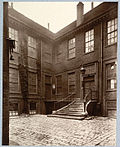 | City of London | Wealthy merchant's mansion with elaborate staircase and panelled rooms. |
| Adelphi Terrace | 1768–1772 | 1930s |  | Adelphi | A neo-classical terrace of 24 houses by the Adam brothers. |
| Army and Navy Club | 1848–1850 | 1950s |  | St James Square | Replaced by a 1950s building on the same site. |
| Austin Friars | 1260s | 1600–1941 |  | City of London | Friary, residence of Thomas Cromwell. Draper's Hall and the Dutch Church remain in reconstructed form. |
| Baltic Exchange | 1903 | 1992 |  | St Mary Axe | Grade II* listed building known for its cathedral-like trading hall and its stained glass windows; destroyed by a bomb in 1992. Site now occupied by The Gherkin. |
| Barnard's Inn | 17th century | After 1879 |  | Fetter Lane | Former Inn of Chancery. Hall still survives, owned by Gresham College. |
| Baynard's Castle | 11th century | 1666 |  | Blackfriars | Destroyed during the Great Fire of London. |
| Bethlem Hospital | 1812–1814 | c. 1931 |  | Southwark | Built to a design by James Lewis. Largely demolished after the hospital moved in 1930. The central part of building survives and has housed the Imperial War Museum since 1936. [1] |
| Blake's House | 18th century | 1965 | 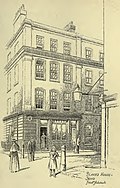 | Soho | Birthplace of William Blake at No. 28 Broad (now Broadwick) Street; demolished to make way for a block of flats. |
| Worshipful Company of Brewers' Hall | 1670–1673.1 [ clarification needed ] | 1940 |  | City of London | In Aldermanbury Square. Rebuilt after the Great Fire; destroyed by bombs. |
| Bridewell Palace | 16th–17th century | 1863–1864 |  | Blackfriars | Residence of Henry VIII from 1515 to 1523; prison and hospital from 1556. Largely rebuilt after the Great Fire of London. Closed 1855. [2] |
| Carlton Club | 1854–1856 | 1940 |  | Pall Mall | By Sidney Smirke; suffered direct hit by bomb in 1940. |
| Carlton Hotel | 1899 | 1940–1958 |  | Haymarket | Prestigious hotel run by César Ritz, with Auguste Escoffier as chef. Badly damaged by bombs in 1940; demolished 1957–1958. |
| Carlton Tavern | 1921 (rebuilt 2019) | 2015 |  | Kilburn | Grade II listed building that was demolished without permission by a property developer, prompting the council to demand its rebuilding. |
| Carpenters' Hall | 15th–18th century | 1876 |  | City of London | On London Wall. First hall dates from 1429; demolished 1876 after being damaged by fire. Second hall destroyed by bombs in 1941. [3] |
| Chesterfield House | 1747–1752 | 1937 |  | Mayfair | Built for Philip Stanhope, 4th Earl of Chesterfield (1694–1773) by Isaac Ware. |
| Christ's Hospital | 17th–19th century | 1902 |  | Newgate Street | School founded 1552; buildings mostly rebuilt after the Great Fire, in part by Wren and Hawksmoor. Relocated to Horsham in 1902. [4] |
| Christ Church Greyfriars | 1687 | 1940 |  | Newgate Street | Rebuilt by Wren after the Great Fire. Largely destroyed by bombing in 1940; the tower and ruins remain. |
| City of London Lying-in Hospital | 1770–1773 | 1940–1941 |  | Old Street | Formerly housed in Shaftesbury House; moved to new building by Robert Mylne in 1773. Damaged by tube construction and partly rebuilt. Destroyed by bombs in 1940 and 1941. [5] |
| Clifford's Inn | 18th century | 1934 |  | Fleet Street | The longest surviving Inn of Chancery, founded in 1344; dissolved in 1903. Only the gatehouse remains. |
| Cloth Fair | 17th century | 1917 | 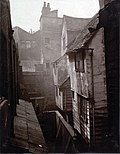 | Smithfield | An area of old houses and narrow lanes adjoining the church of St Bartholomew-the-Great, including the Old Dick Whittington Inn. One 17th-century house survives. |
| Coal Exchange | 1847–1849 | 1962 |  | Lower Thames Street | One of the earliest examples of cast-iron construction, demolished for road-widening, which did not take place until the 1980s. [6] |
| Corn Exchange | 1828 | 1882 |  | Mark Lane | The building was designed by George Smith in the Greek Revival style. [7] |
| Crosby Hall | 15th–17th centuries | 1909–1910 | 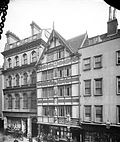 | Bishopsgate | Great hall re-erected in Chelsea and incorporated into a new building by Walter Godfrey. Many other buildings in Bishopsgate which escaped the Great Fire survived into the Victorian period. [8] |
| Crystal Palace | 1851 | 1936 |  | Hyde Park | Built by Joseph Paxton for the Great Exhibition of 1851. Rebuilt in a different form in South London, 1854; destroyed by fire. |
| Cumberland House | 1763 | 1908–1912 |  | Pall Mall | By Matthew Brettingham; occupied by the Board of Ordnance, later the War Office, from 1806. [9] |
| Devonshire House | c. 1740 | 1924 |  | Piccadilly | Built by William Kent for the Dukes of Devonshire. |
| Doctors' Commons | c. 1670 | 1867 | 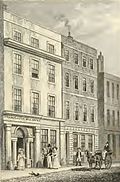 | City of London | College of Advocates, or Doctors of Law, where proceedings of the Court of Arches, the Prerogative Court, and others were held. In Knightrider Street. Buildings arranged round two quadrangles; rebuilt after the Great Fire, sold in 1865, and subsequently demolished. |
| Dorchester House | 1853 | 1929 |  | Park Lane | Palatial house built by Lewis Vulliamy for Robert Stayner Holford; replaced by the Dorchester Hotel. |
| Drury Lane | 17th century | 1890 | 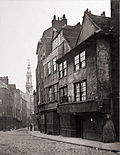 | Drury Lane | Old houses which survived the Great Fire of London, including the former Cock and Magpie tavern (with sign), which had become Stockley's Bookshop by 1876. [10] |
| East India House | 1729 | 1861 |  | Leadenhall Street | Designed by amateur architect Theodore Jacobsen. Much of British India was governed from here until the British government took control in 1858. |
| Egyptian Hall | 1812 | 1905 |  | Piccadilly | Designed in the form of an ancient Egyptian temple for William Bullock, who used the building as an exhibition centre. |
| Euston Arch | 1837 | 1961–1962 |  | Euston | Original entrance to Euston Station; demolition was approved by Ernest Marples, who believed that the cost of moving the arch could not be justified. |
| Fleet Prison | 1781–1782 | 1846 |  | Farringdon Street | Built 1197; rebuilt after the Great Fire and again after the Gordon Riots in 1780. Closed 1842. |
| Foundling Hospital | 1742–1752 | 1926 |  | Bloomsbury | Designed by amateur architect Theodore Jacobsen. Founded by Thomas Coram, the hospital relocated to Redhill in the 1920s, and later Berkhamsted. [11] |
| Fowler's Mill | 1788 | 1825 |  | Battersea | Horizontal windmill, milling continued by steam until 1892. |
| Furnival's Inn | 1818 | 1897 |  | Holborn | Former Inn of Chancery, rebuilt after the Inn was dissolved in 1817; home of Charles Dickens from 1834 to 1837. |
| General Post Office | 1829 | 1912 |  | St Martins-le-Grand | By Sir Robert Smirke. |
| Great Synagogue of London | 1788–1789 | 1942 |  | Aldgate | By James Spiller; centre of Jewish life in London, destroyed in The Blitz. |
| Great Wheel | 1894–1895 | 1907 | 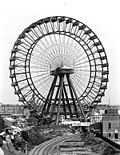 | Earls Court | Constructed by Maudslay, Son & Field. Built for the Empire of India Exhibition at Earls Court in 1895. It had carried 2.5 million passengers at its time of closure in 1906. |
| Grosvenor House | 1732–1843 | 1927 |  | Park Lane | Originally Gloucester House, purchased in 1805 by Robert Grosvenor and subsequently enlarged. [12] |
| Haberdashers' Hall | 1671 | 1940 | 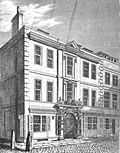 | City of London | In Maiden Lane. The original hall was destroyed in the Great Fire and rebuilt by Edward Jerman. Destroyed by bombs. |
| Holford House | 1832 | 1944–1948 |  | Regent's Park | Home of Regent's Park College from 1855 to 1927. Suffered bomb damage in 1944; demolished 1948. |
| Holland House | 1605 | 1940 |  | Holland Park | Largely destroyed by bombs in September 1940; some remains still stand and house a youth hostel. |
| Imperial Hotel, London | 1911 | 1967 |  | Russell Square | Designed by Charles Fitzroy Doll. |
| Imperial Institute | 1893 | 1957–1958 |  | South Kensington | Designed by Thomas Edward Collcutt. Demolished from 1957 to make way for Imperial College; the Queen's Tower survives. |
| Inner Temple, Library & Hall | 1827–1868 | 1940 | 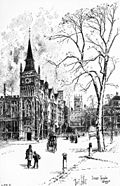 | Fleet Street | Gothic library of 1827–1828 by Sir Robert Smirke and adjoining hall of 1868 by Sidney Smirke; destroyed by bombs. |
| Jacob's Island | 17th–18th centuries | Late 19th century |  | Bermondsey | Notorious slum, featured in Oliver Twist . Partly destroyed by fire in 1861; replaced by warehouses in the late 19th century. |
| Junior Carlton Club | 1869 | 1963 |  | Pall Mall | Replacement by a 1960s building led to the loss of members and the merger of the club with the Carlton Club. |
| King's Mews | 1732 | 1830 |  | Trafalgar Square | Rebuilt by William Kent. Succeeded by the present Royal Mews in 1825. |
| London Colosseum | 1827 | 1874 |  | Regent's Park | Designed by Decimus Burton, and built by Thomas Hornor at huge expense to house a 360-degree panorama of London painted by Edmund Thomas Parris. |
| London Institution | 1815 | 1936 |  | Finsbury Circus | Built by Thomas Cubitt. Founded in 1806 "to promote ... Science, Literature and the Arts", the Institution closed in 1912. The building was then used by London University. |
| Londonderry House | 18th century | 1965 |  | Park Lane | London house of the Marquess of Londonderry, transformed during the 1820s by Benjamin Dean Wyatt and Philip Wyatt. |
| Mappin & Webb Building | 1870 | 1994 | 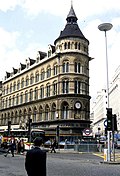 | Bank | Designed by John Belcher, the listed building, [13] was demolished by developer Peter Palumbo to be replaced by Sir James Stirling's No 1 Poultry. |
| Merchant Taylors' School | c. 1675 | After 1875 |  | City of London | School founded in 1561. Located in the Manor of the Rose, Suffolk Lane – a building rebuilt after the Great Fire – until 1875. |
| Middlesex Hospital | 1755–1757 | 1927 |  | Fitzrovia | First opened in 1745. Moved in 1757, rebuilt in 1924 after being declared structurally unsound, and closed in 2005. |
| Millbank Penitentiary | 1812–1821 | 1892–1903 |  | Pimlico | Constructed as the National Penitentiary after Bentham's Panopticon was abandoned. The design proved unsatisfactory, and the building became a holding depot for convicts awaiting transportation. |
| Montagu House, Portman Square | 1777–1781 | 1941 |  | Portman Square | Built for Mrs. Elizabeth Montagu, patroness of the arts, to the design of the neoclassical architect James "Athenian" Stuart. Damaged by an incendiary bomb. |
| Montagu House, Whitehall | 1859–1862 | c. 1925 |  | Whitehall | Palatial house in French Renaissance style, designed by William Burn for the 5th Duke of Buccleuch; used as government offices from 1917. [14] |
| Newgate Prison | 1770–1782 | 1904 |  | Old Bailey | First built in 1188; closed 1902. The Central Criminal Court now stands on the site. |
| Newton's House | c. 1695 | 1913 | 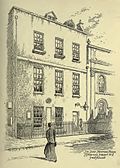 | Leicester Square | 35 St Martin's Street was the residence of Sir Isaac Newton from 1710 to 1725. [15] |
| Norfolk House | c. 1748 | 1938 |  | St James Square | By Matthew Brettingham. The restored Music Room is displayed in the Victoria and Albert Museum. [16] |
| Northumberland House | c. 1605 | 1874 |  | Trafalgar Square | London residence of the Dukes of Northumberland. |
| Old London Bridge | 12th–17th centuries | 1758–1831 |  | River Thames | Houses on the bridge were demolished in 1758–1762, the rest after the completion of a new bridge by John Rennie in 1831. |
| Old Mansion House | 1668 | 1929 | 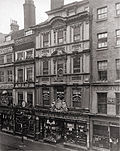 | Cheapside | Built by Sir Christopher Wren for Sir William Turner, Lord Mayor of London from 1668 to 1669. |
| Old Queen's Head Tavern, Islington | 16th century | c. 1826 |  | Islington | Once renowned ancient tavern in Essex Road, formerly Lower Street. Rebuilt c. 1826; still trading. |
| Old St Paul's Cathedral | 1087–1314 | 1666 |  | Ludgate Hill | In severe decline by the 17th century; destroyed in the Great Fire of London. |
| Olympic Park McDonald's | 2012 | 2012 |  | Queen Elizabeth Olympic Park | A temporary McDonald's restaurant constructed to coincide with the 2012 Summer Olympics and Paralympics. During its operation, it was the world's largest McDonald's establishment, and served 14,000 people daily. It operated for six weeks before being dismantled, with most building materials being repurposed or recycled. [17] |
| Oxford Arms, Warwick Lane | 17th century | 1876 |  | City of London | One of the last surviving galleried inns in London. |
| Pantheon | 1772 | 1937 |  | Oxford Street | By James Wyatt. Rebuilt after a fire in 1792. Marks & Spencer bought the building from a wine merchant and had it demolished to make way for their new store. |
| Pembroke House | 1723–1759 | 1938 |  | Whitehall | Largely rebuilt 1756–1759; demolished with other buildings in Whitehall Gardens to make way for the new MOD building. [18] |
| Pope's House | 17th century | 1872 |  | Lombard Street | Birthplace in 1688 of the poet Alexander Pope at Plough Court, Lombard Street. |
| Queen Square | 1716–1725 | 19th century |  | Bloomsbury | Many of the original houses were converted for use as hospitals. The square today is largely occupied by hospital buildings. |
| Regent Street | 1814–1825 | 1895–1927 |  | Regent Street | Originally built by John Nash as a new thoroughfare, entailing much demolition. Completely redeveloped 1895–1927. |
| River Fleet | 17th–18th century | 18th–19th century |  | Blackfriars | River converted into New Canal by 1680; covered, partly by New Bridge Street, prior to the opening of Blackfriars Bridge in 1769. |
| Rolls Chapel and Rolls House | 1617–1718 | 1895–1896 |  | Chancery Lane | Rolls Chapel rebuilt 1617, attributed, but without evidence, to Inigo Jones. Rolls House was built 1718 by Colen Campbell. Demolished to make way for the former Public Record Office, now the Maughan Library, King's College London. |
| Royal College of Physicians, Warwick Lane | 1679 | 1887 |  | City of London | By Robert Hooke. Used as a foundry after 1825, damaged by fire in 1879, and demolished in 1887. |
| Royal Panopticon | 1854 | 1882 | | Leicester Square | Showcase venue for the best achievements in science and arts of the time; converted to a theatre after only two years. Destroyed by fire. |
| St Antholin, Watling Street | 1678–1684 | 1874 | 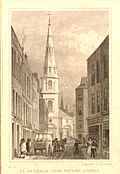 | City of London | Rebuilt by Wren after the Great Fire. The roof took the form of an elliptic cupola, supported by composite columns. |
| St Luke's Hospital for Lunatics | 1786 | 1963 |  | Old Street | By George Dance the Younger; closed 1916. The buildings were used as a printing works by the Bank of England until the 1950s. |
| St Mary Aldermanbury | 1668 | 1940 |  | Gresham Street | Rebuilt by Wren after the Great Fire; destroyed by bombing in 1940. Reconstructed in Fulton, Missouri, using original stones. |
| St Paul's School | 1823 | 1884 |  | Cheapside | School founded 1509; buildings rebuilt 1823 by George Smith. Demolished when the school moved to Hammersmith in 1884. |
| St Thomas' Hospital | 1699–1742 | 1862 |  | Southwark | Begun in 1699 by Thomas Cartwright. Demolished to make way for a railway; the hospital relocated to Lambeth in 1871. |
| Savoy Hospital | 1505 | 1816–1820 |  | Strand | Founded by Henry VII on the site of the Savoy Palace; closed in 1702. Demolished to make way for approach to Waterloo Bridge. Savoy Chapel survives. [19] |
| Schomberg House | 1694 | 1956 |  | Pall Mall | Divided into three (Nos. 80–82) in 1769. No. 80, home of Thomas Gainsborough from 1774 to 1788, was demolished in 1850; the rest replaced by offices in 1956. Facade survives. |
| Serjeant's Inn, Fleet Street | 18th century | 1941 | 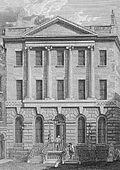 | Fleet Street | Rebuilt by Robert Adam and taken over by the Amicable Society after the serjeants moved to Chancery Lane in 1730. Destroyed by bombing. [20] |
| Serle's Place | 17th century | 1866 | 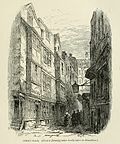 | Strand | Part of a cluster of alleys and courts demolished to make way for the Royal Courts of Justice. |
| Shaftesbury House | 1644 | 1882 | 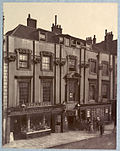 | Aldersgate Street | This building at nos. 35–38, once known as Thanet House, was built by Inigo Jones. It later became a tavern, then a lying-in hospital, then a dispensary. [21] |
| Shakespeare's House | 16th–17th century | 1879 |  | Aldersgate Street | No. 134, formerly the Half Moon Tavern, was falsely linked to the playwright; its site is now occupied by Barbican tube station. The nearby Shakespeare Tower preserves the association. [21] |
| Sir Paul Pindar's House | 17th century | 1890 |  | Bishopsgate | Became a tavern in the 18th century. Its frontage is preserved in the Victoria and Albert Museum. |
| South Sea House | Before 1773 | c. 1903 |  | Threadneedle Street | Home of the Baltic Exchange from 1866 to 1903. |
| Talbot Inn, Southwark | 17th century | 1874 |  | Southwark | Formerly the Tabard Inn, a medieval coaching inn, burnt down in 1676 and rebuilt. The meeting place of Chaucer's pilgrims in The Canterbury Tales . |
| Tavistock House | c. 1805 | 1901 | 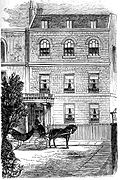 | Tavistock Square | Built by James Burton. The home of Charles Dickens from 1851 to 1860, its site is now occupied by the headquarters of the British Medical Association. |
| White Hart | 15th–16th centuries | 1829 |  | Bishopsgate | A once-renowned ancient tavern. The building dated to 1480 and was rebuilt in 1829. Closed in 2014; the facade was integrated into a 9-storey office block. |
| Whitehall Palace | 15th–17th centuries | 1698 |  | Whitehall | The largest palace in Europe, residence of English monarchs from 1530 to 1698. The entire palace, except for the Banqueting House and the Holbein Gate, was destroyed by fire. The Holbein Gate was then demolished in 1759. |
| Winchester House | 16th century | 1839 |  | City of London | Great Winchester Street; built by William Paulet, 1st Marquess of Winchester. |
| Wych Street | 16th–17th centuries | 1901 | 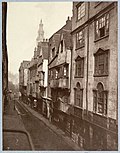 | Aldwych | Part of the area around Drury Lane that survived the Great Fire of London; the street contained decrepit Elizabethan houses, with projecting wooden jetties. |